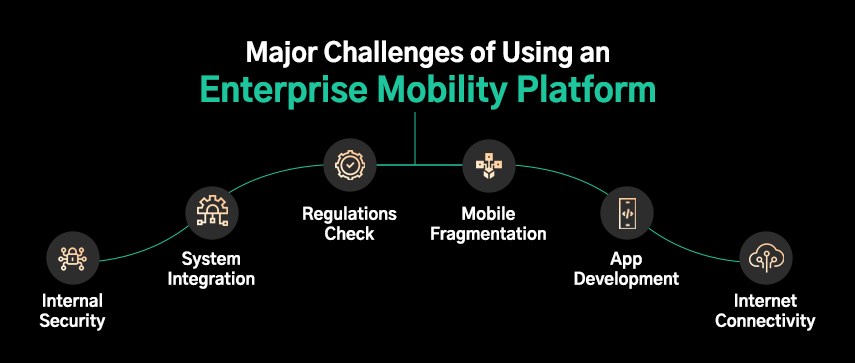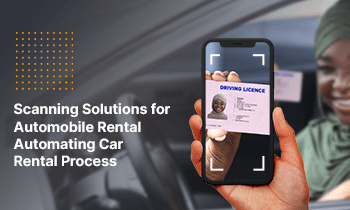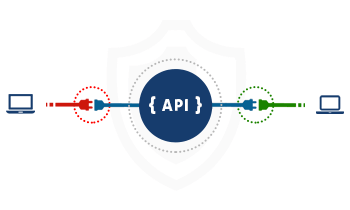As mobile devices witness massive utilization across the corporate world, it’s bringing numerous opportunities for enterprises to transform their overall operational workflow. Many of them are willing to incorporate enterprise mobility across their daily operations and be a part of the market, which is expected to reach $11.96 billion by 2026. But they also come across various challenges that restrict them from gaining the needed outcomes.

As such, analyzing these enterprise mobility challenges and finding out effective solutions to counter them has become the need of the hour. But to successfully approach this, you need to understand the concept of enterprise mobility and its related solutions in a more detailed manner. So, let’s take a look.
What are Enterprise Mobility Solutions?
Experts define these solutions as the key to offer automated and remote working options. To make it more simple, an enterprise mobility solution provider can help you reduce the overall complexities involved in managing corporate data on various mobile devices.
Enterprise mobility is also known as business mobility that acknowledges the need for greater agility brought about by a shift from the conventional central office business model. It enables the effective use of laptops, mobile devices, and cloud technology.
With such solutions in hand, you can set up technologies, processes, and employee policies in order to manage and safeguard both corporate and employee-owned mobile devices. Here’re the fundamental objectives of an enterprise mobility solution to give you a better idea.
- Streamlining remote communication and end-to-end operational connectivity.
- Offering access to real-time data and resources available on the company’s own devices and increasing the overall productivity of the employees.
- Channelizing the virtual flow of information and reducing dependency on paper-based operations.
- Prioritizing data security and avoiding loss of business-critical information.
Why is Enterprise Mobility important?
As said earlier, businesses face various enterprise mobility challenges while making a company-wide implementation. But this implementation also brings numerous advantages to the table for both employees and employers. Let’s take a look at some of them and understand the significance of business mobility.
Offers Flexibility
Employees are able to work from anywhere, and they are able to access information in real-time. This means that a business is able to stay in contact with the employee and reach out to them in just a few clicks. Employees, for example, sales staff, can also search and access the information they need without visiting the office.Improves Collaboration
The biggest benefit of leveraging this enterprise mobility trend is boosting in-house and on-site collaboration, especially when multiple team members work on the same project. Besides, when rightly coupled with the cloud-based tools, it helps employees to update the project progress and procure regular coordination.Reduces Overhead Costs
Maintenance of an office, staff, devices, and infrastructure is a costly process. However, if more employees are working from home or remotely, then all these costs can be minimized. As a business owner, you shall only be paying for the software and other costs related to virtual machines, servers, etc.Manages Data Efficiently
Comprehensive data gathering is important for any business to make data-driven decisions. With dynamic mobile apps backed by a robust enterprise mobility system, it’s easy to gather, manage, and keep track of all user data, thereby adding more value to customer engagement and business growth.Enables Instant Reporting
Integrating an enterprise mobile reporting system into your existing mobility solution enables your staff to view and share project reports instantly. These reports can be further observed from any device to analyze certain business KPIs. It also helps to assess the performance of all the team members.Increases Customer Satisfaction
The right enterprise mobility strategy can help your brand in reaching the target audience via mobile applications. It will cater to their requirements, including promoting discounts & offers, resolving issues, addressing grievances, etc. in real-time. Altogether, the strategy would deliver quick and reliable customer support service.
Major Challenges of Using an Enterprise Mobility Platform

Indeed, enterprise mobility provides various benefits as mentioned above. But building a platform that not only elevates the digital experience but is also compatible with all available devices is nothing less than a challenge.
Among mobile devices alone there are multiple Operating Systems (OSs). Whether it’s coding, design, or security, every OS needs to be handled differently, which can further aggravate the following enterprise mobility challenges:
Internal Security
When employees have access to internal data and systems, there is a high possibility of breaches, malware attacks, and other viruses entering the main system. Simply allowing employees to use mobile devices with unconfined access is not a good practice and imparts risks to data mismanagement in the future.System Integration
Sometimes, mobile devices do not integrate well with the existing systems and eventually disturb the entire data flow and operations. It hampers the constant exchange and synchronization of information among the employees. The chances of mobile devices getting disconnected increase.Regulations Check
There are certain regulations such as HIPAA and GDPR that have specific methods and rules for storing and using the information on a mobile device. Placing business data into these devices without understanding the nitty-gritty of these regulations leads to violation and penalty.Mobile Fragmentation
When companies try to incorporate a large variety of devices and operating systems into one business system, it may result in mobile fragmentation. The system may not be compatible with all these devices because developers and manufacturers have different methods of creating their solutions.App Development
Keeping in mind the functionalities, features, and vulnerabilities of different operating systems while creating an app is one of the major challenges. Besides, the developers also have to go through a complicated process of performing constant testing, checking code, and searching for potential bugs.Internet Connectivity
Be it in-house, on-site, or remote working employees, inconsistencies in internet connectivity lead to poor mobility. The mobile devices linked with the business system start facing communication issues. And as more devices get connected, these issues only get complicated and users witness slow loading.

Solutions to Overcome these Enterprise Mobility Challenges
Now, as you have come across the major challenges concerning enterprise mobility, let’s walk through some of the solutions that can help you overcome these challenges and lay the foundation for a progressive work environment.
1 Improving User Experience
To rightly channelize your enterprise mobility management strategy, you need to prioritize indispensable user experiences across your entire organization. These experiences should be driven by user-friendly apps that empower your team to operate and access information from anywhere.
Decisions have to be made about the apps being installed – whether they are to be created from scratch, the functionality, and how to make them compatible with the existing system. You also need to ensure that the apps offer seamless navigation alongside eliminating any kinds of security flaws.
2 Choosing the Right App Development Team
You can either build your apps with the help of your in-house team or choose to outsource them. To get the best results, you can hire mobile app developers from Mobisoft who are well-equipped with the latest technologies, skills, and experience to build highly responsive mobile apps.
This would simplify the mobile app development process and help you develop apps for various platforms, including Android and iOS. Also, a dedicated team with a good understanding of each platform shall understand your requirements in a better manner.
3 Keeping Up with The Latest Technology
The introduction of digital wearables, AI glasses, etc., seems exciting but it also means that you have to acknowledge these technologies while establishing your enterprise mobility system. Ensure that your brand stays up to date with the latest technology trends and exploits it accordingly.
This approach would also allow you to upgrade the infrastructure, help with system integrations, and generate employee satisfaction. Just make sure the system is open for modifications when it’s being built as a closed system would not support the necessary upgrades.
4 Employing Advanced Security Protocols
Focusing on end-to-end data encryption would be a great practice to overcome various enterprise mobility security challenges. You can also partner with professionals who know the intricacies of online security and create standards to ensure that no data can be tampered with.
You need to outline certain advanced protocols and multi-level security measures to avoid any kinds of breaches, bugs, and extremely challenging OS vulnerabilities. Besides, creating stringent authentication methods and providing essential access to your personnel can prove beneficial in the longer run.
5 Creating a Cloud-based System
Deploy an enterprise mobility system that can exchange data easily through the cloud. This shall influence better connectivity for various mobile devices and apps. Also, your developers can create both offline and online versions of the apps, allowing employees to use them from anywhere at any time.
This shall eventually reduce the load on the network servers and boost internet connectivity. Apart from this, you also need to create a cloud-ready application architecture to have stable data storage capabilities and increase the computing power of your enterprise mobility system.
The Final Words
You can defy all the enterprise mobility challenges if you clearly target your essential business requirements, understand the importance and take full advantage of a mobility platform. This shall not only transform the way you operate but also enhance your operational efficiencies. And with this addition to your existing business model, you can manage mobile devices, wireless networks, and other mobile computing services more efficiently than ever before.

Author's Bio

Nitin Lahoti is the Co-Founder and Director at Mobisoft Infotech. He has 15 years of experience in Design, Business Development and Startups. His expertise is in Product Ideation, UX/UI design, Startup consulting and mentoring. He prefers business readings and loves traveling.


